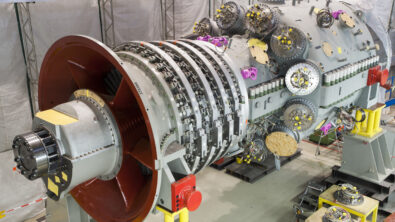Adopting additive manufacturing in aerospace

Back for season two of the Additive Manufacturing podcast from Siemens Software, Ashley Eckhoff is tackling what the technology means for the aerospace industry. Joining Ashley for the first episode of the season is Dale Tutt, VP of Aerospace and Defense at Siemens Digital Industries Software. With over 30 years of experience in industry at companies like Virgin Group’s The Spaceship Company and Cessna Aircraft before that, Dale has a very wholistic view of how the market has been adopting the technology.
Just like every other industry looking at additive manufacturing, or AM, aerospace shares many of the same benefits of adoption. But many of the advantages produce a far greater effect because of how development and the aircraft themselves are structured. The most common benefit examples for AM are the ability to light-weight components, rapid prototyping of new designs and the creation of exotic geometries unavailable to traditional manufacturing methods. And for each of these, aerospace has an overwhelming benefit to adoption.
Light-weighting
Dropping weight without losing strength is a benefit to every product, but the cost of weight in aerospace can’t be compared. Every added pound in an aircraft has a lower bound of $5,000, but that can inflate rapidly depending on where the weight needs to be dropped or if it is a commercial jet or a satellite. Shedding ten to twenty percent of a component’s weight by topology optimization and internal lattices without dramatically changing the component strength is a game-changer for aerospace, especially while balancing the center of gravity of an aircraft.
Rapid prototyping
Tooling is one of the most daunting manufacturing processes to change for any industry, traditional manufacturing processes are built around fast production of large lot sizes. So, when it comes to changing out, say a nose cone, for an aircraft prototype it can take upwards of ten weeks to see the results of the design change. Rapid prototyping essentially removes that barrier. Components set for rapid prototyping can be printed directly and other manufacturers might implement AM to create the mold in a hybrid- casting model. Regardless of the implementation, AM accelerates prototyping from a timescale of weeks to days, or even hours. In an increasingly competitive development process, this can be invaluable to aircraft manufacturers looking to edge out the competition.
Exotic geometries
One of AM’s greatest strengths is how limitless the printable geometries are compared to traditional manufacturing methods. This potential lends itself to many unique applications, for example the flight decks of commercial airliners are so packed with navigation systems, flight controls and sensors readout panels that adding components without completely reworking the design is near impossible. At least this was the case, when an aircraft OEM needed to install extra cooling channels to the flight deck to improve pilot air supply and windshield visibility, ducts were design with topology optimization and 3D printed to fit perfectly into the extra space. Not only does AM enable custom componentry like this, it does so faster and cheaper than any approximations that could be made with other methods.
These are all great benefits, but implementation is not as simple as design it, build it, use it when it comes to aviation. Even non-AM parts using a new manufacturing process need to be qualified and approved by the relevant agencies before they can help an aircraft take to the skies. Fortunately, in part due to lessons learned in the adoption of composites and partly due to cost benefits of the technology, OEMs are implementing additive technologies and processes in secondary and tertiary systems to qualify them for later use in primary systems.
For a more complete understanding of the discussion, listen for yourself. Ashley Eckhoff and Dale Tutt have plenty to talk about regarding additive manufacturing in the aerospace industry, so much so they already have a second episode planned. Check out the Siemens AM podcast page for more episodes or they are all available on your favorite podcast platform.
Siemens Digital Industries Software is driving transformation to enable a digital enterprise where engineering, manufacturing and electronics design meet tomorrow.
Xcelerator, the comprehensive and integrated portfolio of software and services from Siemens Digital Industries Software, helps companies of all sizes create and leverage a comprehensive digital twin that provides organizations with new insights, opportunities and levels of automation to drive innovation.
For more information on Siemens Digital Industries Software products and services, visit siemens.com/software or follow us on LinkedIn, Twitter, Facebook and Instagram.
Siemens Digital Industries Software – Where today meets tomorrow
About the experts:
Ashley Eckhoff has a background in engineering and has been with Siemens for over 20 years in various capacities. He has spent the past few years deep-diving into additive manufacturing in both product design and marketing roles.
Dale Tutt is the Vice President of Aerospace and Defense Industry for Siemens Digital Industries Software. He is responsible for defining the overall Aerospace and Defense industry strategy for Siemens Digital Industries Software, driving specific industry requirements into solutions for Aerospace and Defense customers. Dale has over 30 years of experience in engineering design, development and program leadership within the Aerospace industry.


